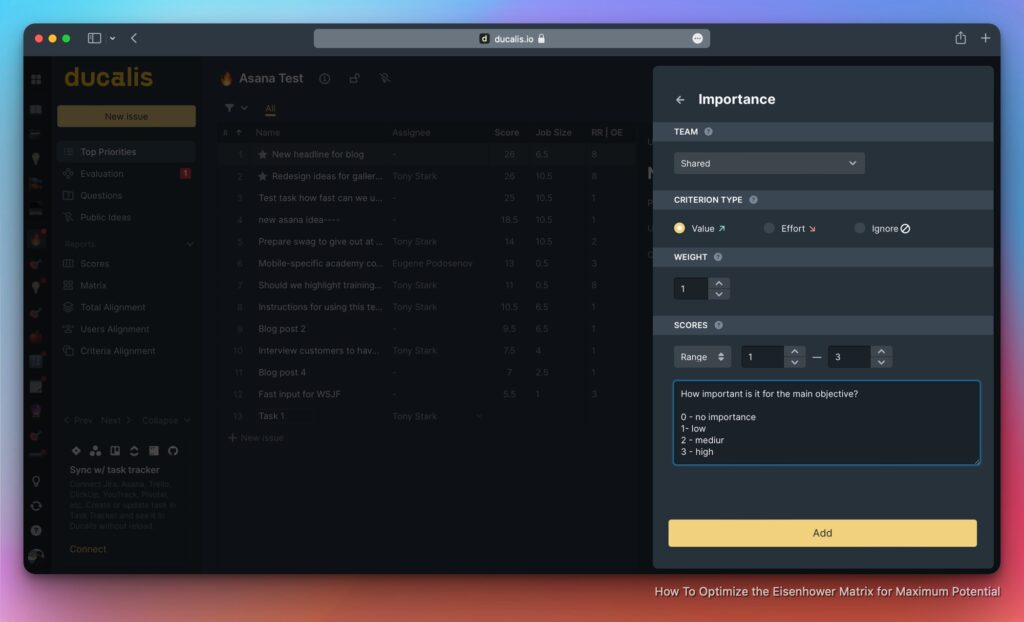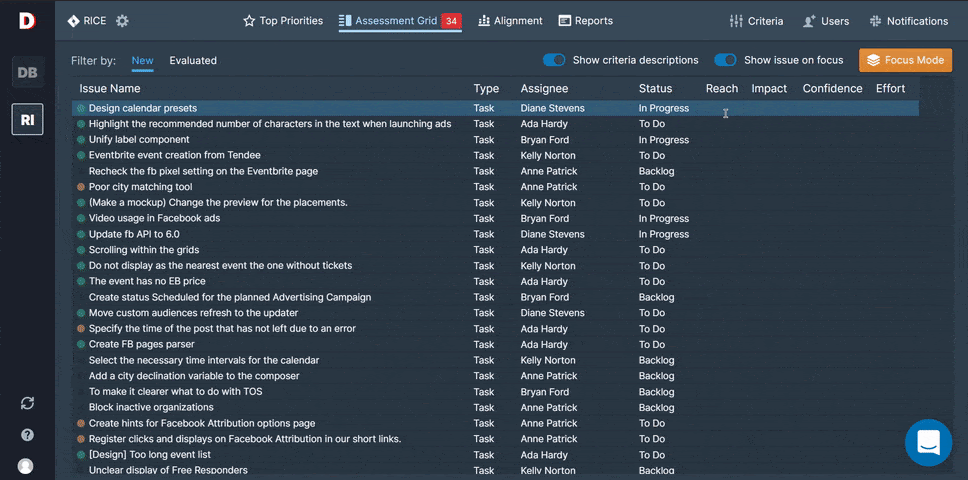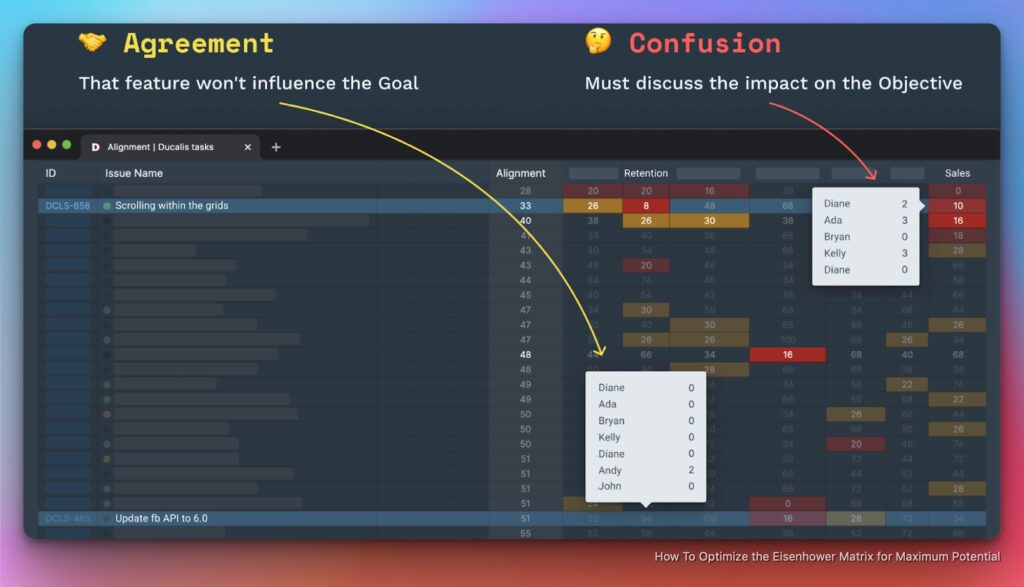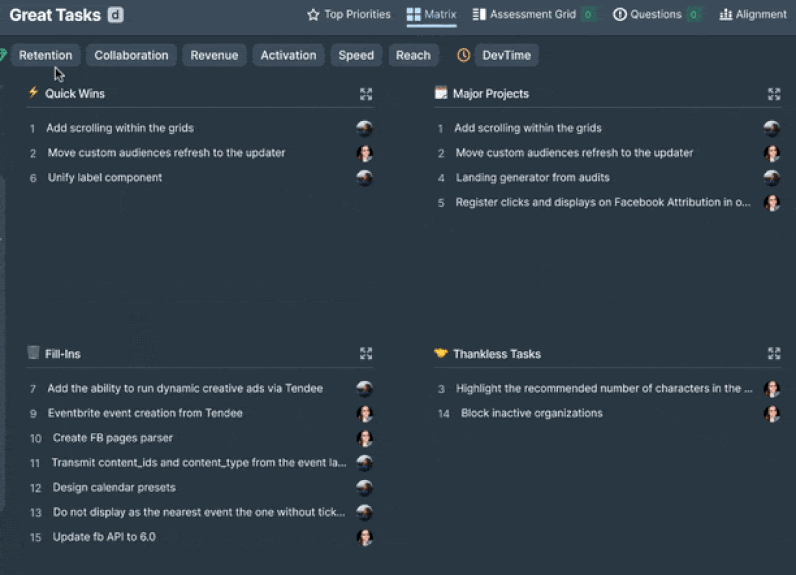Battling with unfinished tasks, the absence of a solid plan, and an ongoing outbreak of emergencies at work? Use the Eisenhower Matrix to prioritize, manage, and distinguish between your important and urgent tasks! But why stop there? Use the latest technological advances to unlock the full potential of the Eisenhower Matrix and take its effectiveness and efficiency to a whole new level! The world and everything around us is constantly changing and evolving, so we will teach you in this article how to optimize your Eisenhower Matrix to the dynamic environment we live in today.
Try Template for Free and start prioritizing your tasks.

“I tell this story to illustrate the truth of the statement I heard long ago in the Army: Plans are worthless, but planning is everything.”
Dwight D. Eisenhower Remarks at the National Defense Executive Reserve Conference, 11/14/57
History Of the Eisenhower Matrix
Dwight D. Eisenhower was the 34th President of the United States of America and a 5-star general during the second world war. He was well-known for his strategic and productive mind. Eisenhower was in charge of organizing and directing Operation Torch, a 1942–1943 invasion of North Africa, as well as the 1944–1945 invasion of Normandy at the Western Front. Signing and sponsoring the Civil Rights Bill of 1957 and the Federal-Aid Highway Act of 1956, which gave rise to the United States’ interstate highway system were among Eisenhower’s achievements as a president. Furthermore, Eisenhower balanced the budget three times, ended the Korean War, and managed to keep the United States at peace by successfully de-escalating Cold War crises while maintaining America’s prestige.
Eisenhower was a master organizer who managed to stay on top of things by distinguishing between the important and the urgent. When asked about what principle he follows when dealing with his numerous tasks, he said, “What is important is seldom urgent, and what is urgent is seldom important.” This principle served as a foundation for what became known as the Eisenhower Matrix.
Through his book, The 7 Habits of Highly Effective People, Stephen Covey popularized the concept of Eisenhower’s framework. As a result, the Eisenhower Matrix has become a widely utilized decision-making and time-management framework in business due to Covey’s work.
What is the Eisenhower Matrix
The Eisenhower Matrix is a time-management, productivity, and prioritization framework that helps you prioritize a list of activities or agenda items by classifying them according to their urgency and significance. It categorizes tasks into four boxes, indicating which should be prioritized, delegated, or deleted.
The Eisenhower Matrix is known by many names such as Urgent-Important Matrix, Eisenhower Decision Matrix, and Eisenhower Box.
When To Use the Eisenhower Matrix
The Eisenhower matrix can help you get back on track if you are experiencing any of the following:
- Lack of long-term goal progress.
- Despite your best efforts, your work is not yielding the desired results.
- You are unable to complete necessary tasks because you spend most of your time dealing with emergencies.
- You have difficulty delegating duties and saying no to people.
- You find yourself constantly procrastinating.
How To Make the Eisenhower Matrix
- Start by creating a box and dividing it into four squares.
- Label the x-axis as Urgent and Not Urgent and label the y-axis as Important and Not Important.
- Divide your entries between the four boxes.
- Tasks in the Important-and-Urgent quadrant should be addressed as soon as possible.
Eisenhower Matrix Template

The Difference Between Important Tasks and Urgent Tasks
Eisenhower developed his prioritization approach based on the difference between urgent and important tasks. To excel at time management, you must be both effective and efficient. In other words, you must allocate time to activities that are important in addition to those that are urgent. This distinction must be understood to avoid the stress of having too many tight deadlines.
- Important Tasks: These tasks contribute to your personal and professional long-term mission, objectives, and values. They might not produce instant outcomes, making them easier to overlook; however, they are occasionally, but not always, urgent. By concentrating on important tasks, you feel calm, logical, and receptive to new ideas due to being in a responsive mindset.
- Urgent Tasks: These tasks are time-sensitive, require immediate attention, and are generally linked to fulfilling someone else’s objectives. You feel compelled to address them. When you concentrate on urgent tasks, you become reactive, making you feel defensive, pressured, and fixated.
Things to keep in mind
- Important tasks might become urgent if you put them off for a long time.
- People tend to assume that all urgent tasks are likewise important, although, in reality, this is usually not the case. This misconception may be due to our predisposition for focusing on current problems and solutions.
How to use the Eisenhower Matrix
Once you’ve created your Eisenhower Matrix, you’ll have four empty boxes (quadrants). So now, you can categorize all of your tasks into four levels of priority:
- Quadrant 1 (Upper Left) – Important and Urgent tasks: This is known as the “Do” quadrant. Tasks in this quadrant are critical and should be your top priority to finish as quickly as feasible (usually on the same day)
- Quadrant 2 (Upper Right) – Important but not Urgent tasks: This is known as the “Decide” quadrant. These are essential long-term goals and tasks that do not yet have a fixed deadline. You should schedule them as soon as possible, starting with the most important ones once you’ve completed everything in the “Do” quadrant.
- Quadrant 3 (Lower Left) – Urgent but not Important tasks: This is known as the “Delegate” quadrant. These are the tasks you should delegate to others. You can assign them to yourself only after the first and second quadrant tasks have been finalized.
- Quadrant 4 (Lower Right) – Not Important, not Urgent tasks: This is known as the “Delete” quadrant. Avoid these tasks at all costs. Tasks in this quadrant vary, depending on urgency and importance. However, most of these tasks are unnecessary and would be regarded as a complete waste of time by most individuals.
Prioritize Your Tasks: How To Be More Productive?
For task prioritization, follow these steps:
- Keep track of your time for a week to see how you spend it according to the matrix. You may log your time in 30-minute intervals in a spreadsheet or using a specialized task management application.
- After one week, sort completed tasks into the appropriate quadrant based on the following (make sure it is based on your goals):
- Was this important to me?
- Was this urgent for me?
- After sorting your tasks, examine their distribution across the quadrants to understand what to do and how to rebalance your matrix if needed. Ideally, you want to have most of your tasks in the second quadrant
Analyzing the Quadrants Of the Eisenhower Matrix
- The “Do” Quadrant: Tasks on this quadrant are critical activities that must be completed as soon as possible, ideally the same day and no later than the next day. These are the activities that must be completed to avoid adverse effects. Crises, deadlines, and pressing concerns are examples of the “Do” quadrant. These tasks generally take the most time and energy during the day because of the amount of effort they require. Spending the bigger portion of your time on Quadrant 1 can cause tension, burnout, and a feeling that your days are spinning out of control. Working all day putting out fires can drain your energy and enthusiasm for your job, making it easier to succumb to Quadrant 4’s mindless escapism.
- The “Decide” Quadrant: These are important but not urgent tasks. They have a far bigger impact on your long-term ability to achieve your objectives. Quadrant 2 allows you to focus on opportunities and growth rather than obstacles and problems. When most of your tasks fall in this quadrant, you are proactive and can prioritize activities that help you improve your abilities and energy while also contributing to achieving important goals. Quadrant 2 is where “deep work” takes place because you are generally free of urgent distractions.
- The “Delegate” Quadrant: These tasks aren’t as important, but they’re nonetheless urgent. Team spirit plays a crucial role in this quadrant. You can perform these tasks yourself, but recommending a suitable candidate for the job will enhance teamwork and provide you more time to finish the activities in the first two quadrants. Keep track of delegated tasks, so you can check up on them later. However, you should know that delegating without the ability to assess progress is pointless since no one can be held accountable. Too much time spent on tasks in this quadrant may make you feel like you aren’t achieving your bigger objectives or don’t have control over your day-to-day life.
- The “Delete Quadrant”: This quadrant is labeled “Delete” since it encourages you to consider the things you shouldn’t be doing and “delete” them from your daily/weekly routine. Discover and eliminate poor behaviors that are a waste of time and don’t help you be more productive. Examples of significant timewasters include browsing the internet for no obvious benefit or wasting time on unimportant and non-urgent emails.
Rebalancing your Matrix
Examine and analyze where and how your time is being spent after your tasks have been organized into the proper quadrants of the matrix:
The majority of time is spent in Quadrant 1: If you spend most of the time in this quadrant, focus on planning and preparation to foresee, detect, and avoid problems.
Solution: Create a weekly/monthly schedule based on your existing objectives and deadlines. Do a weekly evaluation and reflection. Consider how well your strategy performed and make adjustments for the next week. If most of your Quadrant 1 tasks originate from outside sources, think about how you might improve your planning and anticipate them better. For example, you may need to collaborate with a client or colleague to establish a more proactive approach or speak with your manager about rebalancing an overburdening schedule.
The majority of time is spent in Quadrant 2: This is the ideal situation to be in.
Solution: distribute and schedule your tasks and activities such that you can take advantage of opportunities and maximize growth. Set a suitable deadline for each step of the task.
The majority of time is spent in Quadrant 3: eliminate or delegate these tasks if possible, to minimize the time spent here.
Solution: Plan out and write down detailed actions for limiting these tasks. Try to:
- Delegate tasks.
- Say no to tasks.
- Discuss how you spend your time with your manager.
If you’re a manager, inform your team that you’ll be delegating work to them so you both can rearrange your priorities.
The majority of time is spent in Quadrant 4: You are likely feeling unfulfilled, avoiding a problem, or stressed out.
Solution: By tracking your time, discover and analyze your top time wasters and devise a strategy for avoiding or limiting them. Prepare a strategy for overcoming procrastination. Remember that while it’s OK to unwind from time to time, activities in this quadrant offer decreasing rewards when performed in excess. Ask yourself:
- What am I trying to achieve?
- Is what I’m doing helping me achieve my goal?
Tips and Tricks for Using the Eisenhower Matrix
- Eliminate distractions and set your own priorities.
- Plan in the morning and then concentrate on your tasks to make the most of your peak performance hours.
- Use time and task management tools to keep track of the progress on the tasks that you delegated.
- Break unhealthy habits such as web surfing and social media during working hours using special tools such as social media blocking software.
- Ask yourself, what is the most important thing to start with? Then, for tasks in the “Do” and “Decide” quadrants, apply Mark Twain’s “Eat the Frog First” concept where you do the hardest “worst” task first. This will give you momentum and energy for the rest of the day.
- Avoid procrastination and overmanagement.
- Fill each quadrant with no more than 8 tasks. Complete the most critical one first before adding more. It’s important to remember that the goal is not about collecting but completing tasks.
- Construct a list of things to do. This relieves you of the burden of continual memorizing. Furthermore, it helps you take responsibility and be accountable for the things you’ve prioritized.
Different Variations of the Eisenhower Matrix
As time passed, different versions of the Eisenhower Matrix evolved to reflect different needs by modifying the criteria on the X- and Y-axis, such as:
- Impact vs. Effort
- Value vs. Feasibility
- PICK Chart: Easy, Hard vs. Low Payoff, High Payoff
- Risk vs. Return
- Business Value, Effort, Risk
- Strategic priority vs. Urgency
- Customer impact vs. Expected to Unexpected
- Complexity vs. Novelty
- Value/Impact vs. Probability of success/Likelihood
- Market newness vs. Product newness
Problems and Drawbacks of Prioritization Matrices
Most prioritization frameworks function by categorizing opportunities/features based on particular metrics, then prioritizing according to the generated list or matrix. This results in two main issues:
- The results of prioritization are rather arbitrary: This is due to the fact that some factors are unknown until a decision has been taken. The potential benefit of a small decision is less than that of a large decision. However, the negative outcome of a big decision is potentially huge. Since the majority of ideas fail, the confidence levels are low. Research and prototyping can help you gain confidence. However, the large number of ideas means it’s impossible to do this with each one. As a result, you need to operate and prioritize in a highly unpredictable environment.
Some frameworks attempt to solve this problem by including confidence as a component. However, it’s still difficult to quantify this ambiguity. Frameworks make it easy to spot high-value low-effort items and low-value high-effort items. Moreover, these are generally straightforward to recognize, even without a framework. The confusing phase comes in the middle when changing a few assumptions may affect the order of ideas and, as a result, the priority.
- Prioritization frameworks address the wrong problems: The main idea behind prioritization is saying no. People believe prioritizing is difficult not because identifying the most promising ideas is challenging, but because it is difficult to say no to less prospective, but nonetheless wonderful ideas.
Big ambitions, overconfidence, and an unwillingness to tell stakeholders that their favorite ideas aren’t going to work can result in teams taking on too many projects. Unfortunately, this causes inadequate handling of many things, not spending enough time researching and understanding the problem, and presenting a hurried solution with a lot of shortcuts. That way, you’re far less likely to provide a decent product.
Even with enough time to implement their priority ideas with the appropriate care and expertise, it is possible that the team has not allocated enough time for revisions that are needed to ensure the expected business value is delivered.
How To Optimize Prioritization Matrices
The problems and drawbacks of prioritization matrices can be addressed in two ways:
- A well-aligned coherent team is far more valuable than any prioritization based on some theoretical framework. Gathering all the inputs and then having a dialogue as a cross-functional, empowered team about the top priorities is a far superior approach to prioritization. If the whole team believes in the idea and plan, which are a ‘shared team decision’, you are more likely to be successful. Everyone will be willing to do their best because they feel to be a part of the process and decision as their opinion is heard and considered. People want the endeavor to succeed, so they offer their best ideas for improvement and brainstorm high-quality solutions.
- Strong leadership: leaders should create clear, well-defined goals for teams while allowing them to make their own priority decisions and then encouraging them to focus on fewer ideas. Only in this manner will the team make innovations that genuinely add value to users and businesses.
Supercharge your Eisenhower Matrix To a New Level
Duclais.io allows you to tailor the Eisenhower Matrix to your organization and optimize it to overcome the traditional drawbacks and problems with the matrix. This can be done by considering the following:
- Your goals and available resources.
- Team alignment.
- Synchronization with your management stack.
- Dynamic approach and adaptability to different tasks.
Build Around your Own Goals and Resources
To get the most out of your prioritization framework, it needs to:
- Consider your team’s goals and the resources available to them.
- Use customized criteria relevant to your term’s objectives and performance.
Role of Ducalis.io
Ducalis.io allows you to do both. There are two main types of customizable criteria:
- Value-oriented criteria: These criteria are focused on your team’s goals and objectives. They include Activation, Retention, Virality, Speed, Sales, Reach, etc.
- Effort-oriented criteria: These criteria are focused on the resources available to your team. They include Dev time, UX time, etc.
This optimization of the Eisenhower Matrix improves its accuracy, efficiency, and reliability.

Empower your Team and Let Every Voice Matter
For your team to operate effectively, it’s crucial to minimize the bias in judgment within your team, which can negatively impact the overall process. An important example of this is the HiPPO effect (Highest Paid Person’s Opinion), when decisions are frequently decided by deferring to the highest-paid individual’s judgment because people tend to disregard an issue’s content to appease the most senior person in the room.
Eliminate this problem using team alignment. When your team is aligned, there is a mutual understanding through which employees from diverse roles and departments communicate and collaborate to achieve team goals and objectives. This has many benefits such as:
- Improved transparency and accountability.
- Improved idea generation and processing.
- Shared accountability for the results.
- Reduced redundancy and improved knowledge exchange.
- Increased trust level among employees and collaboration.
Role of Ducalis.io
Ducalis.io provides you with 5 tools to achieve team alignment:
- Customizable prioritization criteria based on your goals. This enables you to create a unique matrix for each team based on their requirements.
- Collaboration in the assessment process. The entire team participates in the evaluation. This is empowering because it includes everyone, encourages the exchange of ideas, and guarantees that everyone’s voice is heard. After seeing how others voted and what they thought about various issues, people understand what is essential and why. As a result, they have a clear image of what has to be done next.
- Analysis of differences in opinions through team alignment grid. The team alignment grid helps you see exactly where your team is at odds. It shows you where there are differences in scores so you can focus on the areas that are causing you problems. In addition, you can see your team’s level of alignment on different tasks depending on how other individuals prioritize the same criteria.
- A section for questions. If there’s something unclear about a situation, the best way to clear it up is to ask questions. Each task has its own area in Ducalis.io, where you may ask and receive inquiries from your teammates. You may also see all of the questions that are being discussed within your team.
- For keeping your priorities up to date, set a score expiration. This function aids in dynamically assessing the importance of issues. For example, you can divide the project into sprints and cycles, then review the significance of tasks in light of changing external conditions. As a result, your team is always engaged and brainstorming new concepts.
When you align your team, you are able to optimize the tradeoff between your goals and resources.


Strengthen your Management Stack
When Dwight D. Eisenhower and Stephen Covey first constructed the Eisenhower Matrix, they would draw it and fill in the tasks. However, things have changed a lot since then. Today, most teams use task trackers such as Jira, Asana, Trello, and ClickUp. Therefore, manually constructing the Eisenhower Matrix and copying the tasks into it from task trackers is a waste of time that could be better used elsewhere.
Role of Ducalis.io
Ducalis.io takes care of this problem for you. In Ducalis.io, all tasks are synchronized with available backlogs and are automatically distributed within quadrants of the matrix. Also, Ducalis.io allows you to combine its potential as a Ducalis.io with the power of your favorite task tracker to give you the best possible results all in one place and with no need for tool switching. Ducalis.io offers you synchronization with Asana, ClickUp, Jira, Pivotal, Google Sheets, Trello, Yandex Tracker, and YouTrack.
Improvise, Adapt, Overcome!
The reality and nature of the work are that it is constantly changing and evolving, making it challenging to find the most productive tasks that simultaneously impact all the criteria simultaneously.
Ducalis.io can help you find answers to questions such as how to find quick wins to improve activation, and what a UX specialist should work on by simply adjusting the relevant criteria. Also, Ducalis.io allows you to update the criteria that you use at any time to help you adapt to the dynamic business environment that you operate in. This gives you the opportunity to focus on real-time goals and reduce backlog noise.
How To Use Eisenhower Box in Ducalis.io To Manage your Tasks and Workload
This can be done easily by doing the following:
- Synchronize your favorite task tracker with Ducalis or add your taste manually via a CSV sheet.
- Once you’ve signed up for Ducalis, personalize your template by defining and customizing your criteria and then assigning weights to them.
- Evaluate the tasks either by yourself or with your team.
- Select the relevant criteria based on your current objectives as a foundation for prioritization.
- The tasks will be placed in the matrix based on the scores that they got.

Why Wait? Get Started Today For Free!
Ducalis.io is a task prioritization tool that helps keep your team aligned around top priorities. It ensures that every team member’s opinion is heard and valued. Decisions are made collaboratively, so every team member feels empowered. Although team alignment is not a one-off thing, if done properly and repeatedly, it boosts team morale and shared understanding and leads to decreased employee turnover in the long run. Ducalis.io has a free trial. Try the Eisenhower Matrix template for yourself and invite team members to get better at your prioritization and team alignment efforts.
